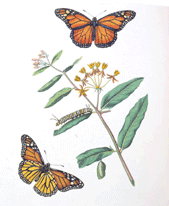

• Intro / Home
• Historical Neighbors
• Street and Backyard
Neighbors
• Park and Green Places
Neighbors
• Shore and Wetlands
Neighbors
• Salt and Freshwater
Neighbors
• Tiny Neighbors
• Unwelcome Neighbors
• Occasional and
Unexpected Neighbors
• Wildlife Sighting Log
• Resources
• Hours and Tours
• NYPL HOME
Urban Neighbors
celebrates a glorious and often overlooked phenomenon of New York
City: the abundance of wildlife within its five boroughs. It refutes
the canard that pigeons, cockroaches, and rats are the city’s
only local wild fauna. Yes, these ubiquitous creatures are familiar "urban
neighbors." But House Sparrows, Crows, Starlings, Gray Squirrels,
House Mice, feral cats, Blue Jays, and Robins also inhabit the
"concrete jungle," as do the Peregrine Falcons nesting
on skyscrapers and bridges, Monk Parakeet communities thriving
on Brooklyn utility poles, and House Finches waking apartment
dwellers with their melodious early morning song. And New York
City offers wild animals much more than buildings and streets.
Extensive green areas – parks, wildlife refuges, and also lawns
and backyards – provide permanent or seasonal homes for many and
diverse creatures: Jamaica Bay Wildlife Refuge recorded 326 species
of resident, breeding, and migrant birds and over 81 fish species
in the Bay, from 1953 to 1990. Central Park, the best known of
the city’s green spaces, has been hailed as one of "America’s
14 best birding sites." Of some 166 species of butterflies
in New York State, more than 134 have been seen here. The waters
of the city’s harbors, rivers, streams, lakes, and ponds – cleaner
now than they have been in many years – are inhabited by numerous
fishes, invertebrates, reptiles and amphibians, water birds, and
mammals. Through arresting images and other objects in various media from the extensive resources of The New York Public Library and photographs from other sources, Urban Neighbors underscores how artists from various places have since the mid-17th century portrayed the animals that are New York City’s "urban neighbors." The online exhibition is organized into eight sections: Historical Neighbors, Street and Backyard Neighbors, Park and Green Places Neighbors, Shore and Wetlands Neighbors, Salt and Freshwater Neighbors, Tiny Neighbors, Unwelcome Neighbors, and Occasional and Unexpected Neighbors. The website for Urban Neighbors features
a sampling of the approximately 250 animal species on view in
the physical exhibition, already a highly selective cross-section
of New York City fauna. Exact locations where a particular animal
has been or may be seen can be found readily in field guides and
checklists prepared by governmental and private organizations.
However, to suggest some of the viewing possibilities for less
common species, some of the image descriptions mention one or
more places where a given animal has been seen. Check out the sighting
log to record your interaction with some of the native New
York City wildlife featured in Urban Neighbors. You may also
browse the sighting log by animal, borough, park or natural area,
and/or habitat to view a sighting you have submitted or to read
others’ observations. We hope Urban Neighbors will inspire New
Yorkers to further investigate the fascinating and often overlooked
local fauna with whom they share their city. Miriam T. Gross
This website is made possible by Sue and Edgar
Wachenheim III and by the Bertha and Isaac Liberman Foundation,
Inc. in memory of Ruth and Seymour Klein. Support for the Exhibitions Program at The
New York Public Library’s Humanities and Social Sciences Library
has been provided by Pinewood Foundation and by Sue and Edgar Wachenheim
III.
|
